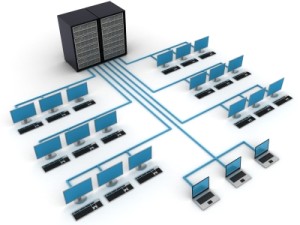 It’s a cold, hard fact that enterprises are putting more strain on their networks now than ever before. On top of this, never before has the risk of downtime been more pertinent―businesses simply can’t afford for their networks to be down, even momentarily, meaning the pressure is on CIOs to ensure that all services are up-and-running all of the time.
It’s a cold, hard fact that enterprises are putting more strain on their networks now than ever before. On top of this, never before has the risk of downtime been more pertinent―businesses simply can’t afford for their networks to be down, even momentarily, meaning the pressure is on CIOs to ensure that all services are up-and-running all of the time.
“Networks today are the foundation for critical, real-time collaboration, CCTV security, call centres, and other business-critical applications. The cost of outages and service impact due to legacy networks in many cases is far greater than the cost of upgrading the network infrastructure,” says Maan Al-Shakarchi, Senior Sales Manager, Avaya.
But networks are getting better at handling the loads placed on them by trends such as mobility, wireless computing, cloud and an ‘always-on’ mentality. Indeed, as enterprises have begun to upgrade their networks, they’ve also been looking at simplifying the convoluted mess of their old legacy infrastructures so that they can react more easily to business demands.
According Al-Shakarchi, it’s all about being able to offer IT services that can move as quickly as business decisions often do. “A company needs to be able to provision services instantly, similar to an individual’s ability to go to Gmail or Yahoo and create a new email account in a few minutes,” he says.
“Networks today are built using the same protocols they were 15 years ago. There is a realisation in the industry that this is no longer good enough to support the trends which are having direct implications on networks, including virtualisation, cloud, and BYOD.”
The point is echoed by Ahmed Youssef, Business Development Manager, MEA, Alcatel-Lucent, who says that the old way of doing things simply won’t be able to cost-effectively handle future demands. What’s in that future? He believes that virtualisation, unified access, BYOD and cloud-ready services are the main trends that CIOs and network managers will have to deal with in the coming years.
There’s a reason why these trends are hitting the IT industry so hard, though, says Youssef; implemented correctly, they can all help to increase network agility and save on costs. Indeed, hardware virtualisation is already highly proven, with most CIOs having opted for at least some form of the technology. This is a great place to start when it comes to infrastructure simplification, Youssef says, though he adds that there are other factors to consider far beyond virtualisation.
“[Simplification] begins by virtualising the hardware as much as possible (which includes application servers, storage, and even desktops). Then, when an organisation is ready to simplify the network design, consideration needs to be given to solutions that offer a pay-as-you-grow design model, the least number of networking tiers, an application-aware and context-aware intelligent solution that is BYOD-ready (i.e. flexible user mobility and powerful automated security), and is future-ready and open-standards-based so that an organisation is not vendor locked-in,” he says.
Before any of this takes place, though, David Hughes, Senior Technical Director, MEA, CommScope, argues that cabling must be a top consideration when it comes to infrastructure simplification.
“Constant and necessary upgrades and developments require new application and software deployments to stay updated with new technology trends such as BYOD and cloud computing. For this reason, the natural progression is to simplify the network, resulting in a unified platform that supports end users’ interactions,” he says.
“Next-generation structured cabling solutions have also taken the complexity out of networking infrastructures. They allow better wireless network operations and make streamlining network capabilities possible. Structured cabling solutions are the backbone of network simplification as many of the new solutions and applications rely on high-bandwidth and high-performance physical layer (cabling) infrastructure.”
The smart design of the layer-1 infrastructure is crucial to any network upgrade, Hughes says. What’s more, with 40G and 100G technology rapidly making its way into enterprises, end-users will soon have a solid foundation on which to plan, deploy and upgrade as needs be. That said, any new layer-1 design should also be mindful of what the network needs to be capable of―business needs should be considered every step of the way when it comes to network simplification, he adds.
What’s more, he concedes that software can play a huge role in the development of next-generation, simplified infrastructures: “By simplifying the network, businesses can lower costs, streamline solutions, deploy applications faster and decrease the possibility of downtime. One third of all network downtime is a result of human error, a problem that can be prevented with the simplification and upgrade of network software.”
According to Manish Bhardwaj, Regional Marketing Manager, Middle East and Turkey, Aruba Networks, there is four-phase approach that businesses can take towards network simplification―analyse, justify, implement and validate.
“The first step in network right-sizing is to analyse your network and financial environment. This analysis provides the foundation of network right-sizing and helps validate the necessity of the right-sizing process,” he says.
The analysis should be a straightforward task, consisting of infrastructure analysis, traffic analysis, where network consolidation can take place, how to implement new technologies such as 802.11ac wireless, and a baseline financial analysis, Bhardwaj says. Likewise, justification for an upgrade should also be a simple issue.
“Strategies and reasons for simplification of a network are numerous. Every organisation is different and will have unique reasons for right-sizing network infrastructure. With budgets being scrutinised and companies looking to reduce costs while improving productivity, right-sizing your network can help you achieve both of these goals. Justification is an important step in evaluating expected financial and other benefits in relation to near-term implementation costs,” he explains.
Bharwaj says that a right-sized infrastructure can cut network capital and operations costs significantly―up 76 percent, according to analyses done by Aruba. There are also green benefits to simplification, too, meaning that justification for upgrading should be manageable.
According to Bhardwaj, the implementation process should include installing a pervasive wireless network and removing surplus equipment that is no longer needed. The wireless point is echoed by Alcatel-Lucent’s Youssef, who says that the concept of unified access is really beginning to take hold across the IT world, simply because it makes things easier.
“Unified access is quickly becoming the premier strategy, which involves the unification of the LAN and WLAN security policies and management that were previously separate silos of configuration and administration. Furthermore, in order to fully take advantage of BYOD mobility and security trends, consideration needs to be given to a fully converged solution of voice, LAN, and WLAN technologies, ensuring that the user ultimately has a seamless user experience across all three domains,” he says.
Software-defined simplification
Naturally, when talking about network simplification, the relatively new concept of the software-defined network (SDN) has to be brought up. SDN has promised much when it comes to managing and automating networks, though, in the Middle East at least, the technology is still taking baby steps. But this does not mean that it shouldn’t be considered with a network upgrade.
“Technologies such as Fabric-based networks and eventually SDN are a great example of eliminating legacy troublesome protocols, such as spanning tree and PIM, and replacing them with a standards-based architecture such as Shortest Path Bridging (SPB IEEE 802.1aq). This allows instant service provisioning, live virtual machine movement between data centres, and simple and scalable deployment of multicast applications such as CCTV and IPTV,” says Avaya’s Al-Shakarchi.
According to CommScope’s Hughes, SDN can work in line with a cloud computing strategy, which can help to increase accessibility while at the same time reducing power consumption. The technology can also reduce on downtime: “When deploying SDN, the legacy infrastructure is reviewed, and can be slowly incorporated on the new system. SDN allows for bilateral communication between wired and virtual devices, and decreases the opportunity of downtime. SDN not only helps to simplify existing networks, but continues to make network growth and application deployment fast and simple,” he says.
It sounds great, but this does not mean that every business in the Middle East is set to jump on the SDN bandwagon. Indeed, according to Hani Nofal, Director of Intelligent Network Solutions, GBM, the region is still set to play host to more traditional-style networks for a while yet.
“We expect to see the expensive network hardware remain relevant in the future. Furthermore, we will start seeing different software-controlled network services that will be driven by custom-built interfaces or application programming interfaces. These will make the hardware smarter and more agile to the specific needs of an enterprise,” he says.





